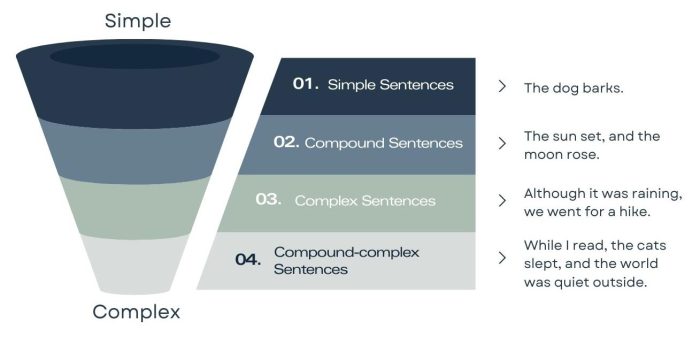Sentence Types by Structure
Today, let’s explore sentence structures, which range from simple to compound-complex. Sentence structures come in four main types, each building on the other in complexity. Let’s start with the most basic one – simple sentences.
Example Sentence Types By Structure
Here are some quick examples with sentence types:
- Simple Sentences: Anna eats a lollipop.
- Compound Sentences: Anna eats lollipops but Jamie eats fruits.
- Complex Sentences: Although Anna eats a lollipop, Jamie eats fruits.
- Compound-complex Sentences: While Anna eats lollipops, Jamie eats fruits, but Matt only eats bread.
Let’s go through each type of sentence with more detail.

Simple Sentence Types
Simple sentences are straightforward and concise. They contain just one independent clause, meaning they have one subject and one verb.
They express a complete thought without commas separating compound elements. Simple sentences are clear and direct. For instance, “The sun rises.”
Each simple sentence stands alone in its meaning. Simple sentences are powerful in their simplicity. But they can pack a punch with a few words.
“The dog barks.”
Compound Sentence Types
Compound sentences connect two ideas. They use conjunctions like “and,” “but,” or “so.” This makes them great for showing contrast or adding information.
Each clause could stand as a sentence on its own. Yet, when joined, they share a closer relationship. The conjunction is like the glue holding compound sentences together.
Common conjunctions are “for”, “and”, “nor”, “but”, “or”, “yet”, and “so”. They also use conjunctive adverbs like “however”, “therefore”, or a semicolon. It also includes conditional sentences.
“The sun set, and the moon rose.”
Complex Sentence Types
Complex sentences add more depth to writing. They combine an independent clause with one or more dependent clauses.
These clauses connect sentences with words like “because,” “although,” or “when.” This structure adds layers of meaning. Complex sentences reveal cause and effect, conditions, or contrasts.
They’re key for detailed explanations and the dependent clause cannot stand alone. Complex sentences need the main clause to make complete sense.
“Although it was raining, we went for a hike.”
Compound Complex Sentence Types
Compound-complex sentences mix the qualities of compound and complex sentences. This means they have at least two independent clauses and one dependent clause combining several ideas.
Compound-complex sentences can illustrate detailed relationships and conditions. This makes this type of sentence structure perfect for conveying complex thoughts with clarity.
These sentences use conjunctions and subordinating conjunctions to connect clauses. Their structure allows for a nuanced expression of ideas, adding depth and variety.
“While I read, the cats slept, and the world was quiet outside.”
Sentence Types by Structure
Understanding sentence structure enhances our writing and communication. We can express ideas engagingly by mixing simple, compound, complex, and compound-complex sentences.
First, simple sentences say one thing clearly. Next, compound sentences connect two ideas with words like “and” or “but”. Then, complex sentences add details with words like “because” or “although”. Finally, compound-complex sentences mix these styles.
